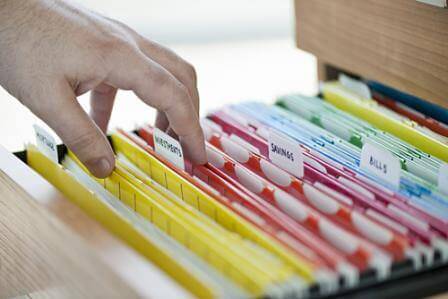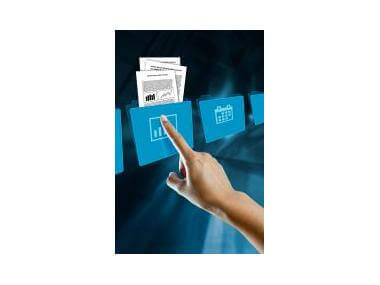How to File Things in Two Places at Once
Some information doesn’t fit neatly into folder hierarchy.
Listener Ann wrote in seven years ago, but I lost her message, and just found it. Hopefully, she’s still a loyal listener. Hopefully, she’s still alive. If not, well, there’s some extra zombie reanimation powder in the storeroom.
Hi! I got a recipe book for Christmas, to store all of my recipes. The problem is though, I don’t know exactly what or how I should sort it.
I could sort by type of meal—breakfast, lunch, snack, or dinner—or by type of food—cookies, cake, salad, etc. I don’t know how I’ll be looking things up at the time. What should I do?
My episode on filing things for retrieval won’t quite do the trick, since Amy anticipates needing to retrieve her recipes many different ways. There’s no one answer. Fortunately, here at Quick and Dirty Tips, we daily conquer the difficult, and weekly accomplish the impossible. So, I think Amy should file one item under both filing systems at once.
In 8th grade, we moved to a new city and I decided, for reasons known only to my bizarre 13-year-old mind (probably some weird puberty side-effect), to pretend I had an identical twin brother. I pulled it off for a few weeks, but what made it fall apart was that I couldn’t be in two places at the same time.
Neither can files. But there are things you can do to file something in multiple places.
File Physical Files in Multiple Places
For example, let’s say you’re a theater fan like me. Not a stalking-and-restraining-order type fan, usually, but the kind of fan who gets your program autographed. You see “Finding Neverland” on Broadway and get Laura Michelle Kelly’s autograph on your Playbill. You file it under “Finding Neverland,” since all your memories of that show are connected to the show’s name. But then you find out that Laura is an Olivier-award-winning actress whose other work you really like. You decide she deserves her own file, “Laura Michelle Kelly,” since you might find other things she’s done that you want to file.
So, now you want your playbill to have two files: “Finding Neverland” and Laura Michelle Kelly. Do it by using a cross-reference. Keep the Playbill itself in your “Finding Neverland” file. Then write on an index card, “Autographed program filed under Finding Neverland.” Put the index card in your Laura Michelle Kelly file. Then, when you’re browsing Laura’s file, you have a reminder that you have her autograph in the Finding Neverland file.
File Electronic Files in Multiple Places
These days, you might be going paperless. In that case, you can use electronic shortcuts to file one file in multiple places. On both the Mac and the PC, you can create an alias, or “shortcut,” to a file. Let’s say you wrote a letter to your mom. You put the original file, “Letter to Mom,” in your “Mom” folder. Then you create an alias that you put in your “Correspondence” folder. When you click the alias, it opens the original file. I use aliases a lot. Since I store my episode audio files on an external hard drive, I have a folder on the hard drive called “Audio recordings.” In my documents directory, I have a separate folder for each Get-It-Done Guy episode that contains the script and an alias for the audio file. So, even though it’s on a different disk, one click opens an episode’s audio from the same folder as the script.
Copying uses twice as much disk space.
On the PC, you create a shortcut by right-clicking on a file’s icon and choosing “Create Shortcut.” The shortcut appears next to the original icon, and you just drag the shortcut anywhere you want to put it. You can also drag an icon while holding down the “Alt” key. When you drop the icon, the original file stays in the same place, but a shortcut back to the original file gets created.
On the Mac, control-click a file’s icon and choose “Make Alias.” Or drag an icon while holding down the Command and Option keys. Either way, you’ll have an alias.
Of course, you can copy a file instead of using an alias, but that uses twice as much disk space, and changes you make to one of the copies won’t show up in the other copy. With aliases, there’s only one master file, so all changes will show up no matter which alias you click on.
File E-mail in Multiple Places
We also file e-mail messages in our e-mail programs. E-mail programs generally don’t have aliases, but you can easily copy messages and keep an exact copy in separate folders. On Windows, just drag and drop an e-mail message to the folder where you want it, but hold down the Control key. The message will be copied instead of moved. On the Mac, hold down Option while you drag and drop. You can copy the message to as many folders as you want. These instructions work for Outlook, Apple Mail, and Thunderbird. Since e-mail messages are typically rather small, copying instead of using aliases isn’t going to eat up your disk drive.
Amy, this is the key to your recipe book. File recipes by type of meal and type of food. And heck, how about also by the name of each dish? Here’s what I’d do: file recipes alphabetically by the name of the dish. So, “Lime Jello, Marshmallow, Cottage Cheese Surprise” would be filed under “L” for “Lime Jello.” Then just jot down the name under the type of food, in this case “Salads” (who knew?). Also jot down the name under the meal type, “Dinner” or “Lunch” or … whatever. Now, if you’re in the mood for a salad, you look under Salads, scan the names, and think to yourself, “Wow! Lime Jello Marshmallow Cottage Cheese Surprise would really hit the spot!” Then you look up the detailed recipe (and it is detailed) by name.
You can’t be in two places at once, but your recipes and paper files can. File index cards as cross references. On a computer, create aliases or shortcuts to files and put the aliases in any folder you might need them. For e-mail, just copy the message to as many folders as you like.
This is Stever Robbins. I help people live extraordinary lives, being extraordinarily productive. If you want to know more, visit SteverRobbins.
Work Less, Do More, and Have a Great Life!
Image courtesy of Shutterstock.







